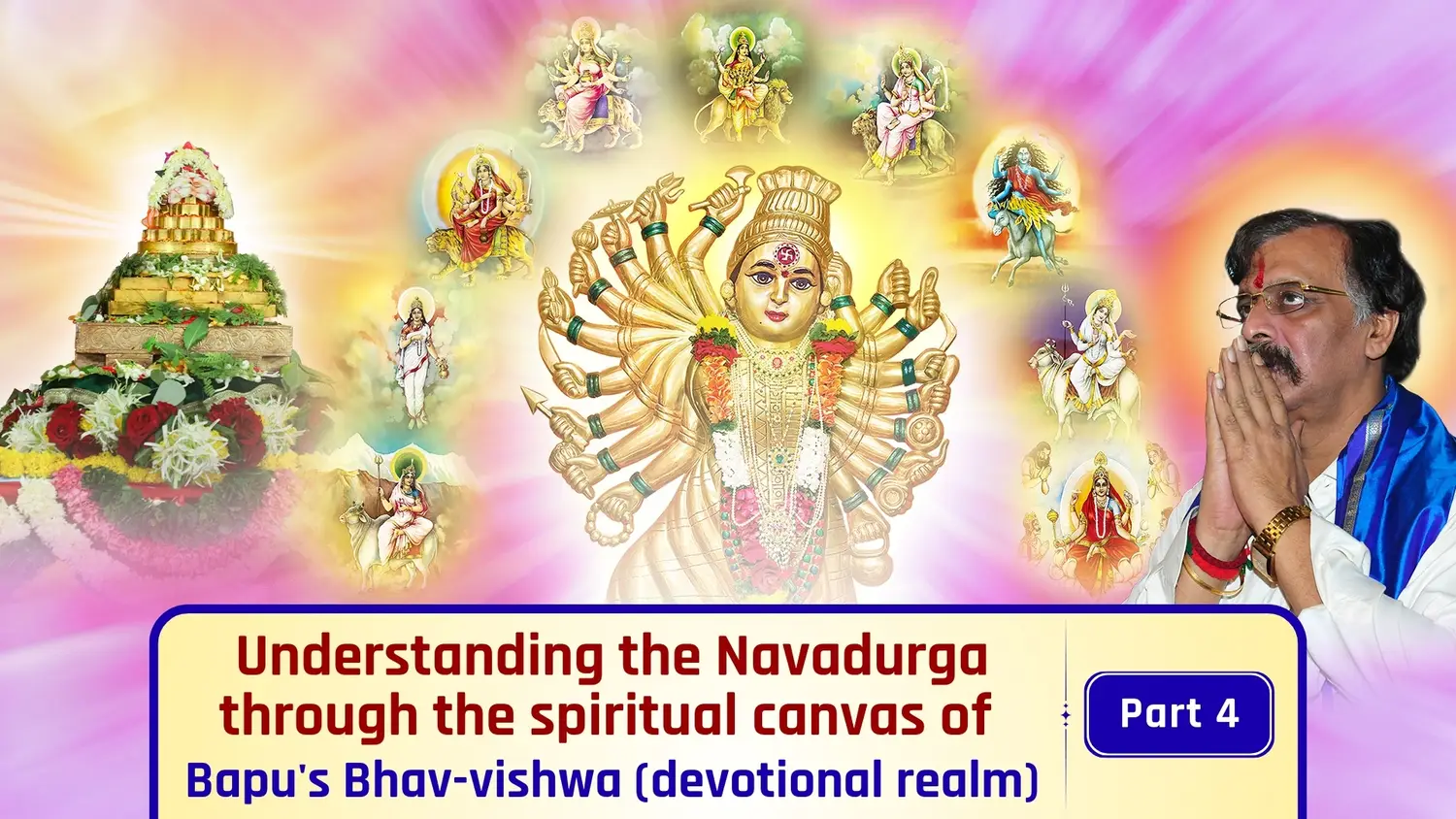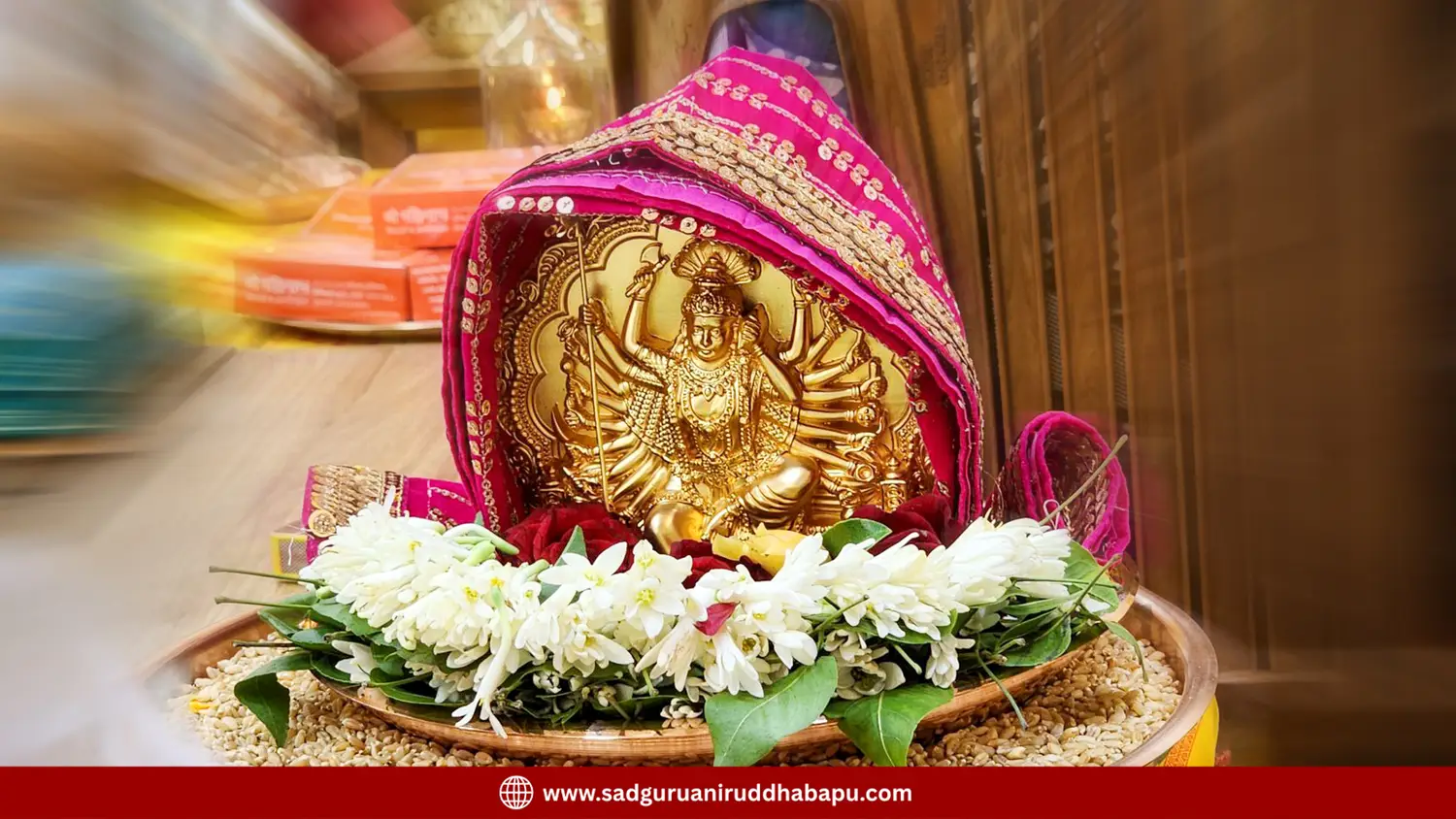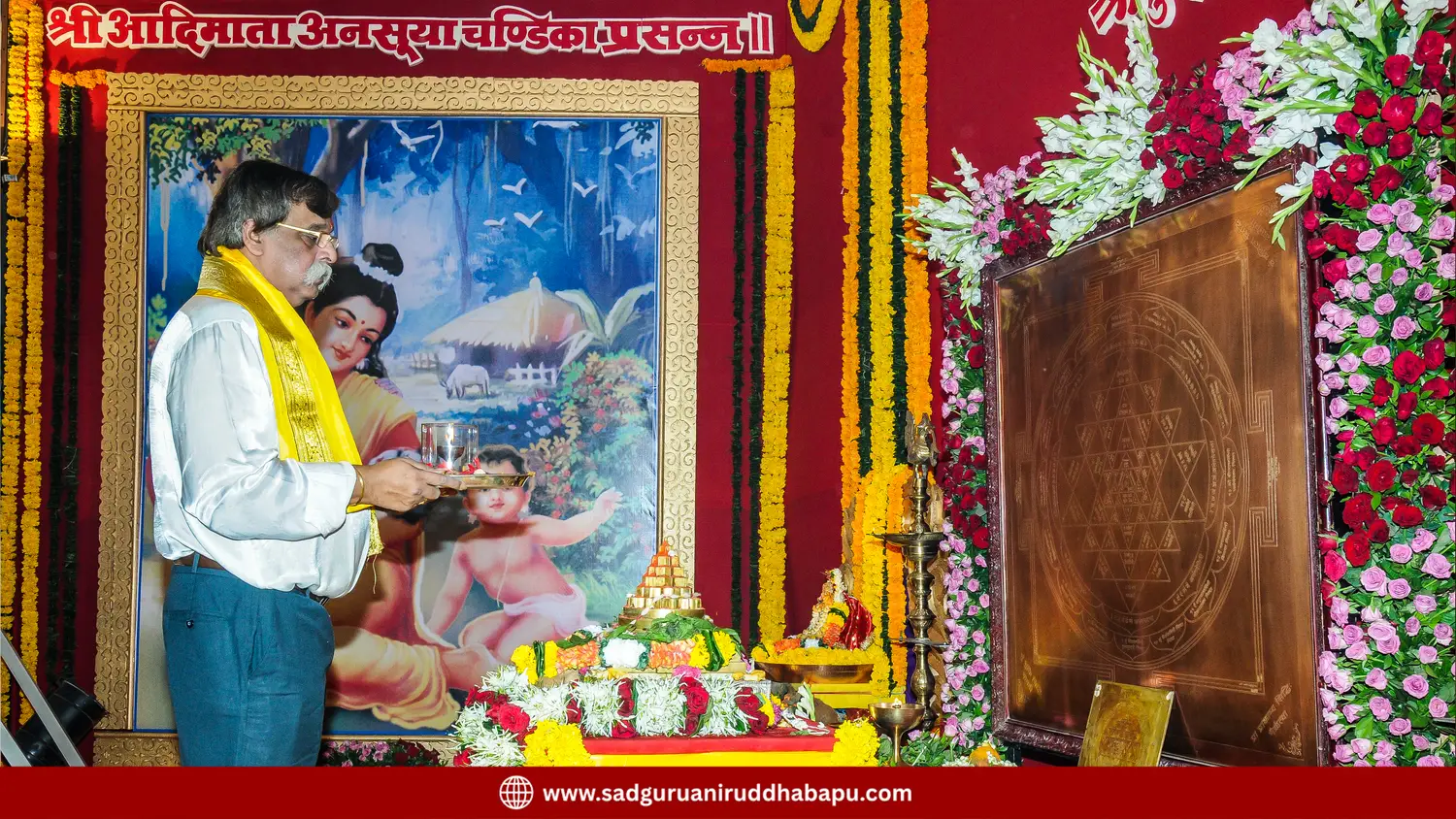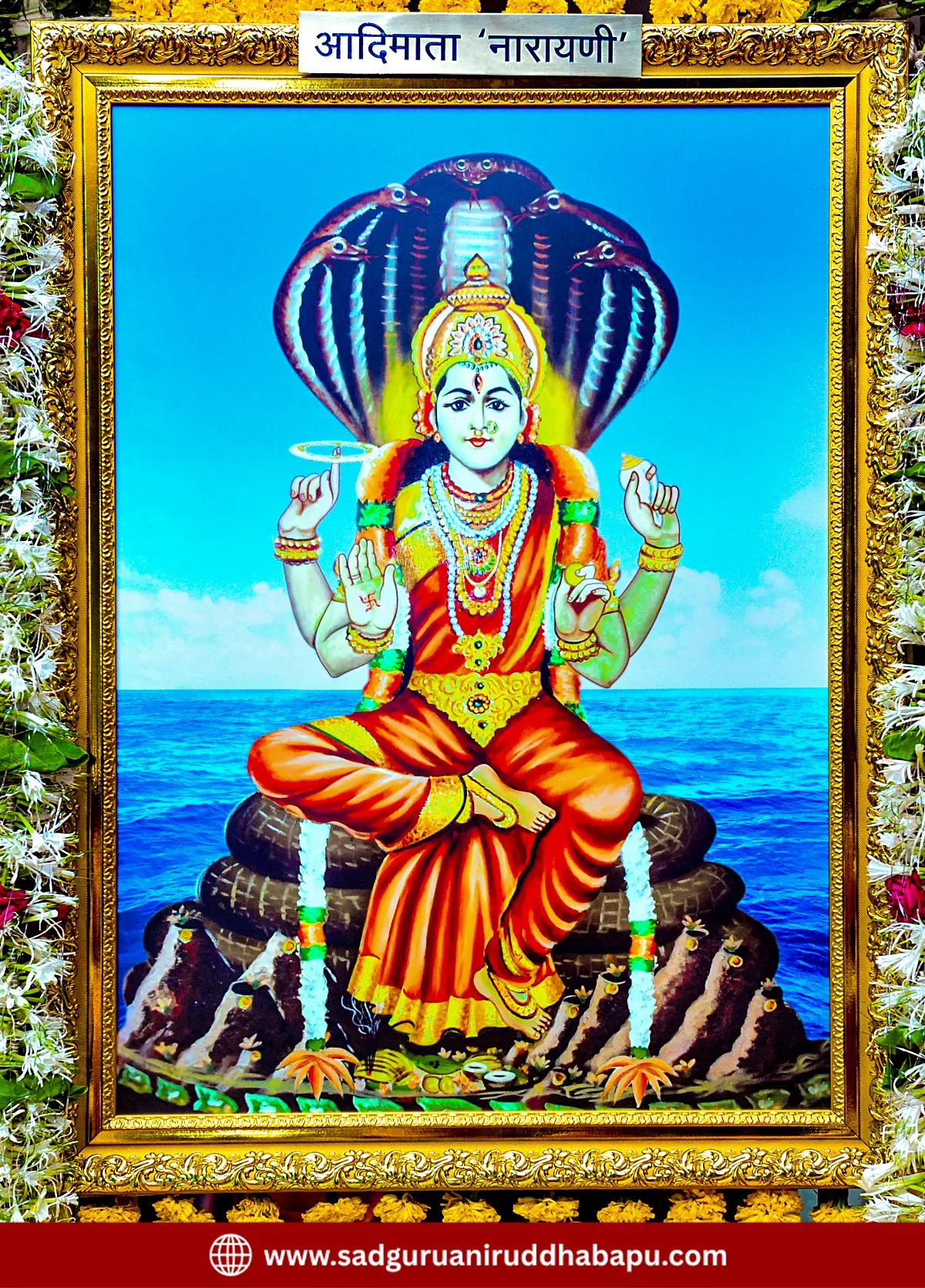Understanding the Navadurga through the spiritual canvas of Bapu's Bhav-vishwa (devotional realm) - Part 4

Previoust Article Next Article
मराठी हिंदी ગુજરાતી বাংলা తెలుగు ಕನ್ನಡ മലയാളം தமிழ்
Reference: From the editorials numbered 1386 and 1387 in the Tulsipatra series of the daily ‘Pratyaksha’ by Sadguru Shree Aniruddha Bapu.
In the Tulsipatra editorial no. 1386, Sadguru Shree Aniruddha Bapu writes:
As soon as Bhagwan Hayagriva departed towards Markandeya’s ashram with the newly married couple, Rajarshi Shashibhooshan very respectfully asked Lopamudra, “O senior Brahmavadini! For the next one month, or perhaps even longer, Gautama and Ahalya will not be here. Then will they miss out on what you will teach from now onwards? This question troubles me, and I ask you, knowing well that you are just and fair.”
Lopamudra replied gently, “I can clearly see in your eyes the tender feelings of a father who has just sent off his daughter with her husband. Honoring your affectionate feelings, I tell you: 1) Both of them will learn the ninth and tenth steps of Shree Shambhavi Vidya thoroughly and in detail from Markandeya. They will also receive all further teachings there itself and will return here at the right time. 2) You have forgotten the most important thing, and that too because of your parental affection. So let me remind you that on Kailash, there is only eternal time. Time itself has no place there.”
Hearing this, Rajarshi Shashibhooshan gratefully thanked Lopamudra with a voice full of emotion, and with complete peace of mind, he again sat down to study with full concentration.
Lopamudra then began to speak again, “The Shree Lalitasahasranama, which is extremely important for the ninth and tenth steps, must also be learned by all of you.
Merely memorizing it or reciting it again and again mechanically is not true practice (Sadhana).
Because every name in the Shree Lalitasahasranama is a channel of essence that energizes and nourishes one or more petals of the Sahasrara Chakra.
Every Brahmarshi and Brahmavadini sitting here attained their position only when an exclusive bond was formed between the Lalitasahasranama and their Sahasrara Chakra. That is, when each petal of the Sahasrara Chakra of a human being becomes filled and completely charged by each name of the Lalitasahasranama, only then is a Brahmarshi or Brahmavadini born.
Now you may wonder, what about others? In fact, you must wonder. Because without questions, there is no effort; without effort, no answer; and without an answer, no progress.
The ninth and tenth steps of Shree Shambhavi Vidya are indeed battles fought within oneself against one’s own inner demonic tendencies.
And no battle can ever be victorious without the Lalitasahasranama.
The side that fights with the support and backing of the Lalitasahasranama belongs to the Devyana path (path of the divine) and attains unblemished victory.
If both sides fight with the backing of the Lalitasahasranama, then Lalitambika herself intervenes in such a battle and brings about reconciliation between the two sides.
Because the form of Lalitambika itself is both the instigator of battle and the bringer of peace.

Therefore, the bow of Lalitambika is not made of any metal; it is made of ever-fresh sugarcane. And her arrows are made of lotus stalks and lotus buds.
Navadurga Skandamata herself is the guide for the study of the Lalitasahasranama, and Bhagwan Hayagriva constantly sings this Sahasranama.
One year after the birth of Bhagwan Skanda, the Skandamata Parvati was so deeply absorbed in the recitation of the Lalitasahasranama that she became completely unaware of everything else.
That one-year-old child Skanda, that is Kumar, while playing, reached the highest peak of the Himalayas (Mount Everest) and was about to leap down from there.
Then Lalitambika, who is ever-alert, immediately reached there and firmly held the right hand of the falling Kumar Kartikeya.
At the same moment, Skandamata Parvati, awakened by her inner motherly affection, also ran from her place towards the peak and held the left hand of the falling Kumar Kartikeya.
Both of them felt immense gratitude towards each other and deep affection for Kumar Kartikeya, who would later become the commander of the army.
Even after being awakened, while running up the peak, and after saving Kartikeya, the recitation of the Lalitasahasranama by Skandamata Parvati continued without interruption.
This greatly pleased Lalitambika.
Now all six faces of Skanda were hungry at the same time, and knowing this, milk began to flow simultaneously from both mothers.
Kartikeya tightly held both their hands and suckled milk from both of them together.
After being fully fed, he burped through all six faces – the burps were not ordinary; they were the natural and spontaneous utterance of the Shree Lalitasahasranama.
Thus, for that moment, Lalitambika and Skandamata Parvati became one.
And just as the Shreeyantra is the united abode of Goddess Lakshmi and Goddess Goddess Mahalakshmi, and the Shreesukta is the united stotra of Goddess Lakshmi and Goddess Mahalakshmi,
in the same way, the Shree Lalitasahasranama became the united stotra of Parvati and Lalitambika, and the Shambhavi Vidya became the united abode of both.”

Bapu further writes in the Tulsipatra editorial no. 1387:
Hearing this entire narrative, the mind of Lord Skanda, who was seated there, was suddenly filled with those old tender memories, and he placed his head at the lotus feet of his mother Parvati and began the recitation of the Lalitasahasranama – spontaneously and effortlessly.
At that very moment, Rajarshi Shashibhooshan saw the form of Skandamata instead of Parvati’s usual Chandraghanta form.
Not only that, but the figure of this Skandamata began to expand slowly and steadily, and in a moment, he felt as if the entire sky was filled with the form of Skandamata.
Along with this, Rajarshi Shashibhooshan stood up and, with a natural and spontaneous feeling, started walking towards the feet of the all-encompassing Skandamata to touch them.
But as he moved closer to those feet, they began rising higher and higher above the earth.
Now the right foot of Skandamata, who was sitting astride a lion, was directed towards the earth in a natural position, while her left foot, bent at the knee, was holding the child Skanda upon it. Hence, though the left foot was horizontal, it appeared vertical.
Rajarshi Shashibhooshan, though the right foot was nearer to him, was completely drawn towards the left foot of Skandamata.
What was he seeing on the sole of that left foot?

Rajarshi Shashibhooshan was completely overwhelmed. He was climbing steps of bliss, one by one, and now he slowly began to speak in a clear voice, “O Skandamata! O Navadurga! On the sole of your left foot, I see the austerities of all the Brahmarshis and Brahmavadinis.
And in front of the eyes of those Brahmarshis performing austerities, I also see only this left foot of yours.
What exactly each Brahmarshi sees on your sole, that I cannot understand – but I can see that their eyes are fixed wide open upon this very sole of yours.
Ah! The two lotus flowers in your left and right hands are now touching the heads of those Brahmarshis.
Ah! The lotus flowers in your two hands are indeed your own Sahasrar Chakras and those of Shiva, and the moment they touch…”
Saying this much, Rajarshi Shashibhooshan became like one dead, with no breath and no heartbeat, and began to float in space.
His wife Poornahuti, with great love and supreme joy, leapt into the sky, held her husband’s right hand in her own, and slowly brought him back to Kailash.
And the moment Rajarshi Shashibhooshan’s feet touched the land of Kailash, he came alive again.
With his very first breath, his Sahasrara Chakra lotus bloomed fully, and everyone could see it spreading in all ten directions from his head.
Many who were not yet Brahmarshis were witnessing how a Brahmarshi is born.
And senior Brahmavadini Lopamudra said, “Now Shashibhooshan has become a Brahmarshi, and you have all seen the entire process of the birth of a Brahmarshi which I spoke of earlier.”
As chants of “Victory to Brahmarshi Shashibhooshan” resonated in the air, everyone present began dancing in joy.
Even Shiva, Mahavishnu, Prajapati Brahma, Ganapati, Veerbhadra, Devarshi Narada, and Shiva Rishi Tumburu joined in this celebration.
And as soon as Brahmarshi Shashibhooshan opened his eyes, he prostrated fully at the lotus feet of the Adimata Shreevidya.

At that very moment, from the mouth of Skanda Kartikeya came forth a marvelous and extraordinary name from the Lalitasahasranama:
“Om Kalpanarahitayai Namah”
And with the utterance of this name, Brahmavadini Lopamudra and Navadurga Skandamata joined their voices with Skanda’s voice and recited this name 108 times.
